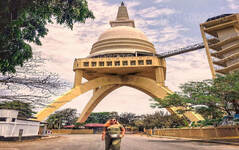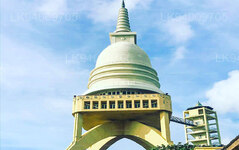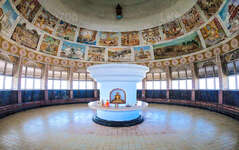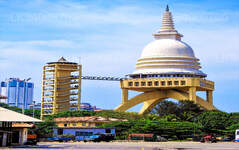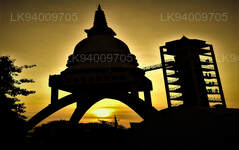
Miasto Kolombo
Kolombo, stolica Sri Lanki, to dynamiczne miasto łączące tradycję z nowoczesnością. Zachwyca kolonialną architekturą, tętniącymi życiem targowiskami i spokojnymi świątyniami buddyjskimi. Z różnorodną kuchnią, rozległą panoramą i pięknymi plażami, stanowi tętniące życiem centrum biznesu, kultury i turystyki, oferując bramę do odkrywania cudów Sri Lanki.
Sambodhi Chaithya
Sri Lanka is a very religious place with a large number of temples, mainly Buddhist and Hindu ones. While some of them are relatively new and mundane, others have an interesting history or story to tell. Colombo, in particular, has an almost even spread of historic religious sites representing all the religions within the island; Buddhism, Hinduism, Christianity and Islam.
Sambodhi Chaithya is a Buddhist Temple with a very unique and interesting architecture. Located within the harbor of Colombo, it stands on a two diagonally intersecting concrete arches that are 11 stories (33m) tall.
The History
The entire structure was designed in 1956 by a highly reputed local engineer, A.N.S. Kulasinghe. The entire project was initiated as part of the commemoration of 2,500 years since the creation of Buddhism reckoned after the Parinirvana (Passing Away) of Gautama Buddha. Named Sri Sambuddha Jayanthi Chaithya after the event’s name, the temple was designed to be viewable by incoming ships, even during storms and bad weather.
The Architecture
The white stupa is bell-shaped, as opposed to the more commonly used dome-shape in modern Sri Lankan architecture, and placed on a square one-story platform balanced on the center of the arches and supported by four struts. The stupa alone is 47m (154 feet) tall, including the conical spire and jeweled pinnacle on top.
A stupa is called a chaithya when it’s built combined with a preaching hall; in other words if it’s a place where Buddhism is taught to many students. In the case of Sambodhi Chaithya, the hall lies beneath stupa – within the one story platform. This platform has four rooms, all representing a single-roomed solitary spiritual cultivation abode usually located in forests, but here it has been customized to a port-city setting for those who wish to still the mind.
Visiting the Chaithya
The Chaithya is located at the end of the road that runs past the Colombo Lighthouse. You will find this fantastic piece of architecture surrounded by grassy spaces, shady trees, and pools of water with picturesque little arched bridges crossing them. The premises are open from early in the morning till 6:00 pm, and entrance is free.
The stupa is reached by climbing up several flights of stairs in a vertical tower alongside. There are a total of 258 steps – a height of 11 floors, all of which have to be climbed barefoot in respect to the temple. You will have to take off your footwear at the base of the tower. The concrete stairway can get burning hot when the sun get high, so you may find it easier to do the climb early in the morning or towards the evening when the heat is lower.
At the top, you will be afforded awe-striking views of the surrounding landscape and the sea. So keep your cameras ready. The access to the stupa is through a heavy steel bridge, crossing the empty space between the staircase tower and Sambodhi Chaithya. The railings are high and very secure so that even the smallest children are safe.
Once you reach the chaithya, you will find yourself passing through heavy wooden doors into the meditation/ preaching hall. From there a staircase will lead up to the main temple. The inner part of the bell-like structure is designed and painted in such a way, that it gives the illusion of being in the endless heavens. The completely while inner walls; the bluish painted on glow emanating from the little flat circle that forms roof of the upside down bell like inner structure; the four devas (heavenly residents in Buddhist culture), on plinths along the walls at cardinal points, with their hands pressed together in worship; all add to this effect. At the middle of it all is the cylindrical shrine with four golden Buddha statues that form the centerpiece.
The upper walls of the inner temple are painted with beautifully detailed scenes from the life of Gautama Buddha and regarding the creation of Sambodhi Chaithya. The art style and color schemes of these murals are faintly Asiatic and do not resemble the usual Sri Lankan traditional boldly colored Buddhist artwork that graces the walls of many temples. These murals were hand painted in November 1986 by the famous local artist and artisan Ven. Mapalagama Vipulasara Maha Thera, who is well known in international circles for his Buddhist artwork and sculptures.
Below the murals are decorative windows looking onto the landscape and the sea, while bas-relief panels regarding Buddhism decorate the lower end of the walls below the windows. The entire effect is that of an attractive art museum more than a traditional temple, and goes towards showing the changes in culture and tradition that Buddhism and Sri Lanka as a whole are undergoing.
After viewing the stupa, and climbing down the multitude of stairs; you can roam around the grounds and see the Bo Tree planted by Lady Srimavo Bandaranaike, along with a number of old anchors, canons, massive chains from ships dating back to the Dutch era, and a vintage steam crane. The Chaithya is also close to the Sri Lanka Ports Authority Maritime Museum, which is housed in a former Dutch prison built in 1676.
With so much to see, a visit to the chaithya is definitely a fun thing to do in Colombo.
O dystrykcie Kolombo
Kolombo to największe miasto i stolica handlowa Sri Lanki. Położone jest na zachodnim wybrzeżu wyspy, w sąsiedztwie Sri Jayewardenepura Kotte, stolicy Sri Lanki. Kolombo to tętniące życiem i pełne życia miasto, łączące w sobie nowoczesny styl życia z kolonialnymi budynkami i ruinami. Liczba mieszkańców wynosi 647 100. Region Metropolitalny Kolombo, definiowany przez dystrykty Kolombo, Gampaha i Kalutara, liczy około 5 648 000 mieszkańców i zajmuje powierzchnię 3694,20 km². Kolombo to miasto wieloetniczne i wielokulturowe. Jest to najludniejsze miasto na Sri Lance, z 642 163 mieszkańcami mieszkającymi w granicach miasta. Populacja Kolombo to mieszanka licznych grup etnicznych, głównie Syngalezów, Maurów i Tamilów. W mieście mieszkają również niewielkie społeczności osób pochodzenia chińskiego, portugalskiego, holenderskiego, malajskiego i indyjskiego, a także liczni europejscy emigranci. Zdecydowana większość lankijskich korporacji ma swoje siedziby w Kolombo. Wśród branż znajdują się m.in. przemysł chemiczny, tekstylny, szklarski, cementowy, skórzany, meblarski i jubilerski. W centrum miasta znajduje się drugi co do wysokości budynek w Azji Południowej – World Trade Center.
O dystrykcie Kolombo
Prowincja Zachodnia jest najgęściej zaludnioną prowincją Sri Lanki. Znajduje się tu stolica parlamentarna Sri Dźajawardanapura Kotte, a także Kolombo, centrum administracyjne i biznesowe kraju. Prowincja Zachodnia dzieli się na trzy główne dystrykty: Kolombo (642 km²), Gampaha (1386,6 km²) i Kalutara (1606 km²). Jako centrum gospodarcze Sri Lanki, w mieście obecne są wszystkie główne lokalne i międzynarodowe korporacje, a także wszyscy najwięksi projektanci i detaliści, dlatego warto przygotować się na zakupy w prowincji Zachodniej. Z uwagi na największą liczbę ludności w całej prowincji, w prowincji Zachodniej znajdują się niemal wszystkie najważniejsze instytucje edukacyjne na wyspie. Do uniwersytetów w prowincji zaliczają się: Uniwersytet Kolombo, Uniwersytet Sri Jayewardenepura, Uniwersytet Kelaniya, Otwarty Uniwersytet Sri Lanki, Uniwersytet Buddyjski i Palijski Sri Lanki, Uniwersytet Obrony Generała Sir Johna Kotelawali i Uniwersytet Moratuwa. W prowincji zachodniej znajduje się najwięcej szkół w kraju, w tym szkoły państwowe, prowincjonalne, prywatne i międzynarodowe.

